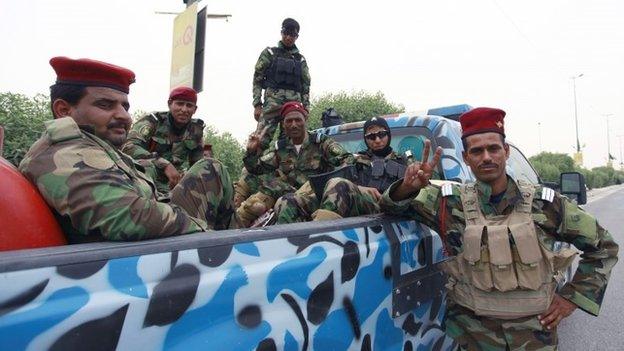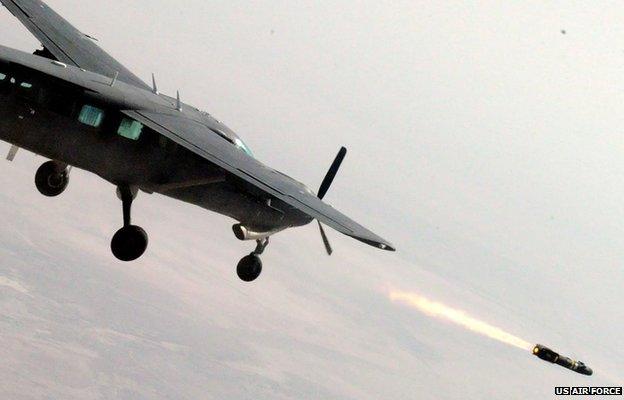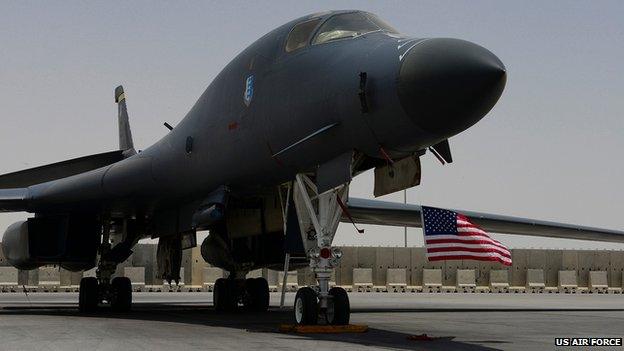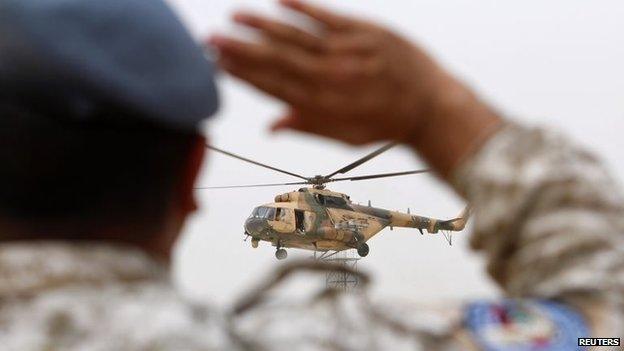Iraq conflict: US air power no remedy for military’s ills
- Published

The rapid success of ISIS-led fighters in seizing territory in western Iraq presents the government in Baghdad with its greatest security problem to date.
Its own poorly motivated forces appear to have largely melted away. It needs to bring rapid firepower to bear and quickly.
The Iraqi Air Force might be one answer - except that Iraq does not really have much of an air force available.
On paper the re-building of the Iraqi Air Force is well under way.
Eighteen Lockheed Martin F-16 fighters are on order from the US, and the first was handed over to the Iraqis at a ceremony earlier this month. Iraq has an option to buy 18 more.
Advanced trainers are on order from the Czech Republic, a variety of helicopters and light aircraft have been purchased from the US, and some orders appear to have been placed with the Russians.

Cessna aircraft armed with Hellfire missiles have reportedly been used in recent days in Iraq
But that is not going to add up to real air force any time soon.
In the interim, Iraqi commanders have had to rely upon stop-gap measures.
Some of its larger Cessna 208B Caravan aircraft - a US-made single-engined turbo-prop that can carry nine passengers - have been armed with Hellfire missiles and there are reliable reports of them having been used in recent days.
Even when the F-16s arrive - and only a handful are expected to be delivered this year - Iraq will still not have the experience or training to use them effectively in ground-attack missions.
Air power used in this way inevitably has the potential to cause civilian casualties and alienate more local Sunnis from the government in Baghdad.
Qatar airbase
So if support needs to be given to bolster the flagging Iraqi military, can the US play a role?
The US is already gearing up to supply additional missiles, other weaponry and more helicopters to the Iraqi armed forces. But might the US deploy its own air power as well?

Al Udeid Air Base is currently home to a wing of B1 Lancer bombers
Reports indicate, external that previous requests from the Iraqi government that the Americans use warplanes and unmanned drones to attack ISIS camps were rebuffed.
But now, given the worsening situation on the ground, might the Obama administration have second thoughts?
The US has a considerable force in place based at Al Udeid Air Base in Qatar, home of the 379th Air Expeditionary Wing. This is almost a mini-air force in itself, made up of a wide-range of aircraft capable of carrying out virtually any mission required.
The base also means that additional strike aircraft can be flown in very quickly.
US aircraft might also operate from Kuwait.
Flagging forces
But US air power alone is no simple answer to Iraq's problems.

The Iraqi military has 270,000 troops, 300 tanks and three combat aircraft
It may temporarily be able to hold the line, but aviation experts suggest that it can only really have an impact if operating with capable forces on the ground.
Bolstering Iraq's flagging military is what is needed and that too might require outside assistance.
Many in Washington may be thinking that things might have been different if US forces had not been compelled to quit Iraq altogether in late 2011.
But the fact remains that the bulk of the problems afflicting the Iraqi military have their origins in the Iraqi government, high levels of corruption and worsening sectarian tensions.
US air power is no remedy for Iraq's fundamental ills.